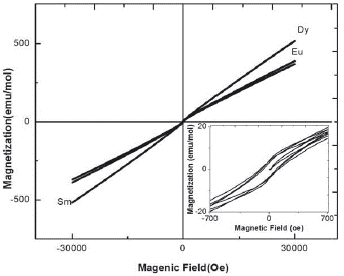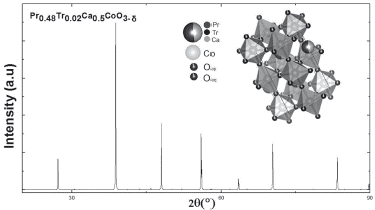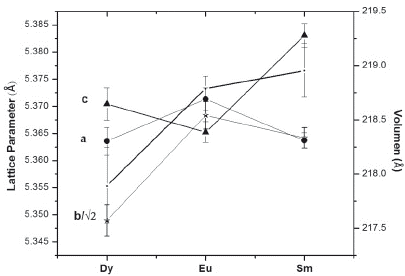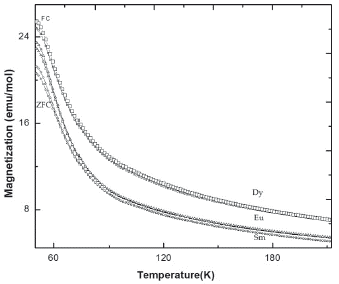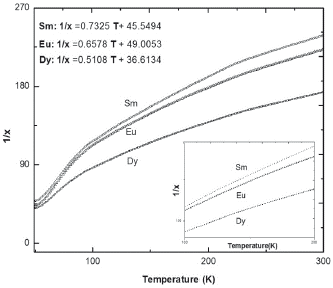Articles of Scientific and Technological Research
Influence of the ionic radius on structural and magnetic response of the system Pr0.48TR0.02Ca0.5Co03-δ
Influencia del radio iónico en la respuesta estructural y magnética del sistema Pr0.48TR0.02Ca0.5Co03-δ
Influência do rádio iónico sobre resposta estrutural e magnética do sistema Pr0.48TR0.02Ca0.5Co03-δ
I. M. Saavedra-Gaona1
G.I. Supelano1
C. Ortiz2
C.A. Parra-Vargas
A.J. Barón-González1
*
1 Grupo de Física de Materiales. Universidad Pedagógica y Tecnológica de Colombia, Avenida central del norte 39-115.
2 Grupo de superficies Electroquímica y Corrosión. Universidad Pedagógica y Tecnológica de Colombia, Avenida central del norte 39-115.
Abstract
The metal - insulator transition (MIT), of the oxides type perovskite formed by elements of Rare Earths (TR), presents an interesting behavior in the family derived from Pr0.5Ca0.5Co03-δ. In this paper it is studied the influence of ionic radius of the rare earth TR in the crystalline structure and in the synthesis of the new family perovskite type Pr0.48TR0.02Ca0.5Co03-δ (TR=Eu,Sm,Dy),produced by the technique of the solid state reaction. The structural characterization of the system was realized by X-rays diffraction (XRD) and Rietveld analysis, demonstrating that the samples crystallize in a orthorhombic structure with spatial group Pnma (#62), without significant changes in phase structural generated by the variation of the ionic radius. They were measurements of magnetization as a function of temperature with the vibrating sample magnetometer VSM of the Quantum Design, in temperature range from 50 to 310K. The curves of the magnetization as a function of temperature presented a similar behavior for all system.
Keywords: cobaltite; structure crystalline; paramagnetic
Resumen
La transición metal-aislante (MIT), de óxidos tipo perovskita formados por elementos de tierras raras (TR), presenta un comportamiento interesante en la familia derivada del Pr0.5Ca0.5Co03-δ. En este trabajo se estudia la influencia del radio iónico de la TR en la estructura cristalina y en la síntesis de la nueva familia tipo perovskita Pr0.48TR0.02Ca0.5Co03-δ (TR =Eu, Sm, Dy), producida por la técnica de reacción en estado sólido. La caracterización estructural del sistema se realizó a través de la técnica de difracción de rayos X (DRX) y análisis de refinamiento Rietveld, con lo cual se demuestra que las muestras cristalizan en una estructura ortorrómbica de grupo espacial Pnma (#62), sin cambios significativos de fase estructural generados por la variación del radio iónico. Se realizaron medidas de magnetización, en función de la temperatura con el magnetómetro de muestra vibrante VSM de la Quantum Design, en un rango de temperatura de 50 a 310 K. Las curvas de magnetización en función de la temperatura presentan un comportamiento similar para todo el sistema.
Palabras clave: cobaltita; estructura cristalina; paramagnético
Resumo
O metal de transição - isolador (MIT), do tipo perovskita de óxidos formado por elementos de Rare Earths (TR), apresenta um comportamento interessante na família derivado de Pr0.5Ca0.5Co03-δ. Neste artigo, estuda-se a influência de radio-iónico do TR na estrutura cristalina e na síntese do novo tipo familiar Pr0.48TR0.02Ca0.5Co03-δ (TR = Eu, Sm, Dy), produzido pela técnica de reação do estado sólido. A caracterização estrutural do sistema foi realizada por difração de raios-X (DRX) e análise de refinamento Rietveld, demonstrando que as amostras cristalizam em uma estrutura ortorrôbbica com o grupo espacial Pnma (62), sem alterações significativas na fase estrutural gerada pela variação da radio-iónico. Foram medições da magnetização em função da temperatura com o magnetometro de amostra vibratório VSM do Quantum Design, na faixa de temperatura de 50 a 310K. As curvas da magnetização em função da temperatura apresentaram comportamento semelhante para todo o sistema.
Palavras-chave: cobaltite; estrutura cristalina; paramagnética
Introduction
The perovskite like cobaltite Pr0.5Ca0.5Co03-δ exhibits an interesting properties such as physical phenomena of spin-state transition, metal-insulator transition and magnetoresistance effect [1-3]. In last years, an important number of researches have been studying the ceramic materials based on this cobaltite using doping for replacement the position of the atoms inside in the crystalline symmetry [4]; in this work, the influence of the ionic-radio will be analyzed for the structural system response of Pr0.48TR0.02Ca0.5Co03-δ where TR=Eu, Sm and Dy by means of the X-rays diffraction patterns (XRD) and Rietveld's refinement analysis in GSAS software.
Experimental details
From the precursors Pr6O11, Co3O4, CaO, Sm2O3, Eu2O3 y Dy2O3 of high purity (>99.99%), three polycrystalline samples were prepared Pr0.48TR0.02Ca0.5Co03-δ (TR=Eu,Sm,Dy) by the solid state reaction method [5]. Oxides were dried at 200°C for 12h and subsequently weighed in appropriate quantities and macerated for 3h in an agate mortar, then they press tablets at a pressure of 2MPa. They surrendered to thermal calcination treatments to 750°C and sinterization to 830°C. The Structural characterization of the samples was carried out through diffraction (XRD) technique in a Diffractometer panalytical x'pert PRO-MPD, using Cu radiation (λ = 1.54186 Å) in intervals of 10° and 90° with steps of 0.02° [6]. The patterns were analyzed by Rietveld refinement. In addition were measurements of magnetization as a function of temperature with the vibrating sample magnetometer VSM from Quantum Design in the temperature range from 50K to 300K using the ZFC-FC (zero-Field Cooled) method. They were measurements of magnetization as a function of the field applied, in a range between - 30kOe to 30kOe to 50K.
Results and discussion
The theorical model of the crystal structure of the system Pr0.48TR0.02Ca0.5Co03-δ is exposed in the Fig 1 whit (TR=Eu,Sm,Dy). This was built from Crystallographic databases, software SPUDS and models proposed by other authors [1,7].
The three samples present peaks of secondary phases, with the symbol ♦ the corresponding reflections are represented to Co3O4 and with the symbol ♣ the reflections corresponding to CoO are represented. The respective XRD bosses allow to infer that the whole system Pr0.48TR0.02Ca0.5Co03-δ it crystallizes in the same spatial group. The results suggest that the size of the ionic radius affects the presence of the second phases. The results by means of analysis for method Rietveld indicate that the samples crystallize in the spatial group orthorhombic Pnma (#62) as the mentioned one in the Fig 1. In the Table 1 the structural parameters are recorded of structure obtained by the Rietveld for every rare earth refining process; these are shown in Fig 3, shown that volume increases in proportion to the ionic radius of rare earth. By comparing the values obtained for these parameters with other authors shows that they are similar [1].
Table 1 Lattice parameters for the system Pr0.48TR0.02Ca0.5Co03-δ obtained from the Rietveld refinement of the XRD patterns.

The figure 4 shows the magnetization curve in function the temperature mode ZFC and FC for a field of 1000 Oe in a range from 50K to 300K, is a behavior observed paramagnetic type. Around 180K the value of the magnetization is similar in rare-earth Eu and Sm, while it is higher in Dy, the curves ZFC and FC are separated near the 70K, 60K y 150K, for the Sm, Eu and Dy respectively; indicating a possible order weak ferromagnetic due to the presence of ferromagnetic clusters.
The Figure 5 shows the magnetization in function of the field to 50K, is perceived as more radio ionic value of magnetization is greater without reaching a saturation value. In the inset shows a behavior ferromagnetic weak which is in accordance with the temperature of the branch FC and ZFC. In the Table 2 summarizes the fields of coercion (HC) and the magnetization remnant (Mr) of each one of the three systems. [8]
Table 2 Coercive field and magnetization remnants of each one of the systems.

The Figure 6 shows the inverse of the susceptibility X-1(T) in function of the temperature for the branch ZFC, showing a linear behavior. In the temperature range between 100K to 200K, an adjustment was made type Curie-Weiss (1/X=1/C T- θ/C) from which was calculated the effective magneton (μelf), obtaining values of 3.30 (4) μB, 3.48 (6) μB and 3.95 (6) μB for Sm, Eu and Dy respectively.
Conclusions
The new system Pr0.48TR0.02Ca0.5Co03-δ was produced by the solid state reaction method. According to the results of Rietveld structure refinement (XRD), the system crystallizes in an orthorhombic system for Pnma space group (#62); the results show that the volume increases with the ionic radius of the Rare Earth doping; however, it preserves the space group. The precedent shows that the employment of CaO as precursor is equally effective in comparison with another samples made with calcium-carbonate precursor (CaCO3) used by other authors [1,4]. By another hand, the magnetization measures have a paramagnetic behavior with a weak ferromagnetic component in low field, and temperatures and the magnetic date interpreted lead to the value between μ = 3.30(4) μB and μ = 3.95(6) μB Bhor magnetons. The Conductivity and magnetization analyses below 50K studies are necessaries, in order to verify the possible existence of metal-insulator transition (MIT) reported on similar systems.
References
[1] Barón-González AJ, Frontera C, García-Muñoz JL, Blasco J. Magnetoresistance in the paramagnetic insulating state of Pr050Ca050CoO3. J.Phys.Conf.Ser. 2010;200(1):012010.
[ Links ]
[2] Tsubouchi S, Kyomen T, Itoh M, Oguni M. Electric, magnetic, and calorimetric properties and phase diagram of Pr1-xCaxCoO3(0≤x≤0.55). Phys. Rev. Lett. 2004;69:144406.
[ Links ]
[3] Naito T, Sumomozawa M, Sasaki H, Fujishiro H. Thermal Conductivity of (Pr1-xREx)0.7Ca0.3CoO3(RE=Sm,Gd) around Metal-Insulator-Spin-State Transition. J. Phys.Conf. Ser. 2009;150:56-9.
[ Links ]
[4] Padilla-Pandoja J, Barón-González AJ, Bozzo B, Blasco J, Ritter C, Herrero-Martín J, García-Muñoz JL. Role of Pr cations and the low temperature transition in Pr0.50Sr0.50CoO3: A comparison to Pr0.50Ca0.50CoO3. J. Elsevier. 2014;455:56-9.
[ Links ]
[5] Barón-Gonzalez AJ, Frontera C, García-Muñoz JL, Blasco J, Ritter C. Role of A-site cations in the metal-Insulator transition in Pr0.5Ca0.5CoO3-Y(Y≈0). Phys. Rev. Lett . 2010;81:054427.
[ Links ]
[6] Canaría-Camargo CC, Sarmiento Santos A, Parra Vargas CA. Magnetic and structural behavior of La1.5-xBa1.5+x-y CayCu3Oz system 0.3≤x≤0.4 and 0.4≤y≤0.5. DYNA. 2016;83(199):108-13.
[ Links ]
[7] García-Muñoz JL, Frontera C, Barón-González AJ, Valencia S, Blasco J, Feyerherm R, Radu F. Valence transition in (Pr, Ca) CoO 3 cobaltites: charge migration at the metal-insulator transition. Physical Review B. 2011;84(4):045104.
[ Links ]
[8] Barón-González AJ, Frontera C, García-Muñoz JL, Blasco J, Ritter C, Valencia S, Dudzik E. Exploration of magnetic order in Pr0.5Ca0.5CoO3δ (δ=0) below the metal-insulator transition. Physics Procedia. 2010;8:73-7.
[ Links ]

